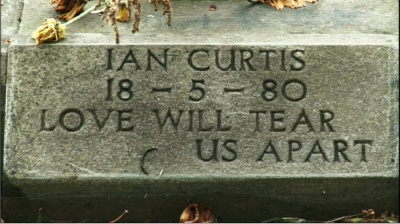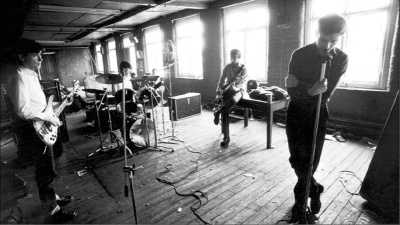 I’ve never been an active fan of Joy Division, owning only the Substance compilation, but I am fond of some of their music (especially They Walked in Line from their days as Warsaw… I’m not sure why this never ended up on any “Joy Division” comps) so I’ve never given them much thought. But once we saw that there was a documentary out about them, considering that they were such a seminal band with such a short dramatic history we decided that it was a must see. So we saw Joy Division.
I’ve never been an active fan of Joy Division, owning only the Substance compilation, but I am fond of some of their music (especially They Walked in Line from their days as Warsaw… I’m not sure why this never ended up on any “Joy Division” comps) so I’ve never given them much thought. But once we saw that there was a documentary out about them, considering that they were such a seminal band with such a short dramatic history we decided that it was a must see. So we saw Joy Division.
After having seen the movie, I would suggest that it still is a must see for anyone with any interest in this band or in “modern” music in general. It was quite good, and produced somewhat different than I would have expected, it had the air of a high quality public television presentation and it was very dark. Lots of grainy old footage of the band back in the day and the current interviews were lit very darkly. Of course, the subject was dark too… Starting with the youthful despair of England and ending in death… The full 4 years from that Sex Pistols concert in 1976 up until the end in 1980.

Using great old still footage and film of the band performing in the clubs around town and the insightful and enthusiastic interviews with involved folks make it a very interesting story of the band, of the scene (musical and otherwise) around Manchester and the development of Joy Division’s sound and album covers. It is a very psychological story that they tell, starting with how the terrible state of social and civil disrepair in England in the late 70’s led to these disaffected youth and their music, the connection between the reality of Manchester and the music of Joy Division and the effect that Ian Curtis and Joy Division had on those that experienced them. They bring in Tony Wilson (the late owner of Factory Records), the designer who put their album covers together, the Belgian journalist who became Curtis’ special friend, Genesis P-Orridge, Pete Shelley and all sorts of folks who really bring the reality of the scene and the effect and importance of the band to the fore.

Of course, Ian Curtis takes a good deal of the focus here as the singer and lyricist (interestingly, the band members claim to have really not paid any attention to what the lyrics of the songs were) who was bipolar and became epileptic. His youthful marriage, being torn between his wife (represented here only through text from her book) and his girlfriend (who is frequently interviewed in the movie) and just his general lack of well-being. The New Order fellows (the remains of Joy Division) all seem like nice regular blokes and the frankness and honesty of the interviews is very heartfelt and revealing.
But there is also more ephemeral matter here, they show some albums that I would very much like to have fall my way and there is a goodly amount of film of the bands early shows, and, that said, Joy Division was worth watching just to catch a glimpse of Ian Curtis dancing.

For special features, it has extensions of the interviews which, though outtakes, are still interesting and are extensive enough to be could well just be another movie. Joy Division is well produced, quite interesting and is pretty much an essential music documentary.









